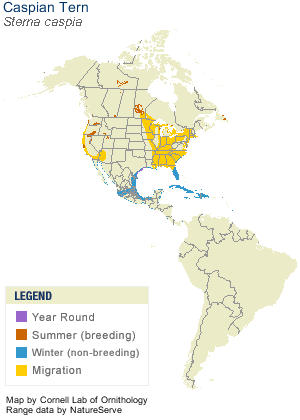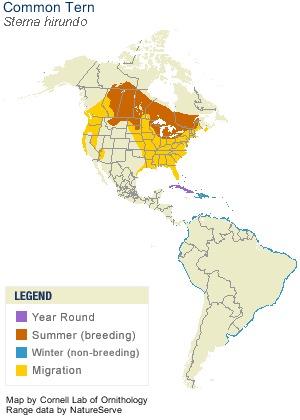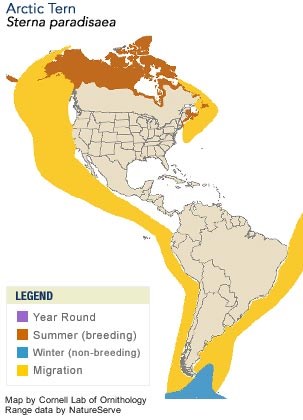
Caspian Terns in Maine
Credit: Mike Fahay
A comical looking bird the size of a small gull with a black cap, gray back and a bill that looked like a carrot was spotted stopping off on a beach in mid-coast Maine last week on its way south. Staying close by its side and making regularly whistley-squawky begging sounds was its youngster that it had raised this summer and was now following its parent on a journey thousands of miles long. The bird was a Caspian Tern, a bird that has been one of my favorites ever since my days at Cornell University in upstate New York where they are a regular migrant coming and going from a large nesting colony on Little Galloo Island in the eastern end of Lake Ontario. If I was to bet, though, I would guess that the parent and young pair that stopped in Maine last week had come from a nesting colony on the shores of the boreal forest ecoregion. There are or have been colonies of Caspian Terns in Quebec along the North Shore of the Gulf of St. Lawrence, on the island of Newfoundland and some small probable colonies in Labrador and these birds very likely came from one of those colonies.

The boreal forest of North America
Credit: Global Forest Watch Canada
Caspian Terns are just one example of a particular group of birds that most birders would not think of as “boreal birds” but the boreal forest ecoregion is actually an important breeding ground for many birds that are sometimes called colonial waterbirds, seabirds, or marine-dependent birds. This includes a few birds that are truly found only in marine environments—birds like Great Cormorants, Black-legged Kittiwakes, Razorbills, Atlantic Puffins, and murres—that nest along the boreal coasts of Quebec, Newfound and Labrador. But more eye-opening are the numbers of certain species that people tend to think of as found only or mainly in marine waters. The list of these is impressive.
Borrowed from Cornell's All About Birds website
Another look at the breeding range of the Caspian Tern, for example, shows that there are large colonies in the boreal from western Ontario through Manitoba and northern Alberta all the way up to Great Slave Lake in the Northwest Territories (where incidentally I remember excitedly pointing one out some years ago in the Old Town section of Yellowknife as it flew over the heads of birding legends Pete Dunne and Scott Weidensaul who were deeply engrossed in conversation until startled by my shouting).
Borrowed from Cornell's All About Birds website
Birders regularly make trips to coastal islands of Canada and the northeastern U.S. to see Common, and especially, Arctic Terns during the summer months and so think of those species as “seabirds.” A glance at a range map however will show that Common Terns nest extensively in small colonies in lakes across the southern part of the boreal forest ecoregion while Arctic Terns do so across the northern part. Both species are famous for their incredible migrations, the Common Tern wintering in southern South America and the Arctic Tern making a mind-blowing circuit to the sub-Antarctic seas for the northern winter before migrating north up the African and European coasts and across the north Atlantic to return to nest. It is possible to see both species in a place like Yellowknife.
I made a short video of an Arctic Tern feeding along the shore of Great Slave Lake in Yellowknife a few years ago that you can see here:
To the layperson any gull is a “sea-gull” even if they see it far from the sea. And gulls do occur far from our coastlines. In fact over 75% of the North American breeding range of Herring Gulls and Bonaparte’s Gulls is found within the boreal forest ecoregion. Both species use the millions of lakes spread across the region that make it the most water-rich in the world. Herring Gulls nest in colonies on treeless islands in these lakes. Last year I came across a small colony on an island on Aikens Lake within Manitoba’s Pimachiowin Aki propsed World Heritage site. Bonaparte’s Gulls have the fascinating life history strategy of nesting in trees along the water’s edge, apparently often using old nests of other birds as platforms. A few summers ago when I was on my canoe expedition with Eddie Nickens in northern Ontario, Bonaparte’s Gulls were regular including right in front of the Wilderness North lodge on Miminiska Lake. Mew Gulls and Franklin’s Gull also have major portions of their breeding range within the boreal forest ecoregion.

Herring Gulls on Aikens Lake in Manitoba
Credit: Jeff Wells
One of the big surprises for me when I first started learning about birds of the boreal was that White Pelicans were found across a wide swath of the region from western Ontario across the Prairie Provinces and up into the Northwest Territories. It is always a little startling when flying over a remote area of boreal lakes or rivers to look down and see a huge white bird with black wingtips slowly flapping over the water. On the opposite extreme of the plumage coloration spectrum, the all-black colored Double-crested Cormorant is also a common bird in many parts of the boreal with more than 25% of its breeding range found in the region.
Even some species that typically require long offshore ocean boat trips in order to see, have parts of their breeding range in the boreal forest ecoregion. Both the Long-tailed and Parasitic Jaegers—hawk-like, predatory seabirds—have breeding ranges that extend south from the Arctic into northern parts of the boreal. Scott Wiedensaul, Linda Dunne and I had the thrilling experience of watching a Parasitic Jaeger chase a sandpiper almost down to our feet as we watched from the shore of Great Bear Lake in Deline in the Northwest Territories one August morning.
During the winter along both Pacific and Atlantic shores of southern Canada and the U.S., there is a regular contingent of waterbirds that are wholly or largely dependent on marine environments. This includes the loons—both Pacific Loon and Common Loon have more than half of their total breeding range within the boreal—and grebes. The stocky Red-necked Grebe is particularly boreal dependent with more than 75% of its range within the boreal and is a common and noisy summer bird in marshy areas including around Yellowknife where I made a short video of one. The tiny Horned Grebe, another common winter sight along both coasts, has over 50% of its breeding range in the boreal.
Red-necked Grebe calls near Yellowknife, NWT:
A few weeks ago I watched a small flock of White-winged Scoters fly by from a vantage point looking out over the ocean near Campobello, New Brunswick. Although I was surprised to see them this early in the season, White-winged Scoters and their two sibling species the Surf and Black Scoters, are one of the regular and enjoyable birds of winter along the coasts of southern Canada and the U.S. In all three species, virtually the entire breeding range occurs only within the boreal.
I hope I haven’t completely smashed all your expectations and understanding of what “seabirds” really are or where they are going to and from. Instead I hope that your appreciation will have increased for the wonderful, mysterious and complex lives of these beautiful birds that can so easily shift from being denizens of the remote freshwater lakes and other wetland habitats dotted across the boreal of Canada and Alaska to being citizens of the salty ocean waves across the hemisphere.
And we haven’t even talked about the shorebirds….
_______________________________________________
Here are a few more videos of common boreal-breeders I've come across in Maine:
Common Loon:
Bonaparte's Gull:




